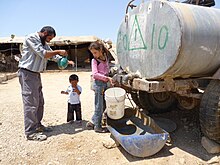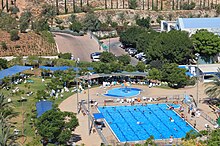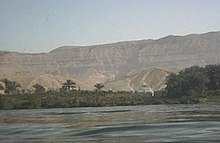Water conflict in the Middle East and North Africa
[1] The conditions that create conflict are only expected to get worse and more complicated, as the full impacts of climate change on the Middle East and North Africa develop over the course of the 21st century.
In total, the Jordan River flows for roughly 350 km, starting in the foothills of Mount Hermon in the north and ending in the Dead Sea to the south.
[3] According to a September 2000 USAF study, over 90% of Syria’s water is shared with neighboring Iraq, Turkey, Israel, Lebanon, and Jordan.
By 1967, Israel’s National Water Carrier was extracting almost 70 percent of the Jordan River before it reached the Palestinians in the West Bank.
During the Mandate, another 200 small groundwater springs were used and rainwater was collected from cisterns, yielding an additional 5 MCM/Y of fresh water during rainy years.
[5] This was rejected by Zionist advocates who envisioned using waters from the Jordan River Basin to settle the Negev Desert in the south of the country.
[4] In the 1947–1949 Palestine war ( the Jewish Army destroyed the Rutenburg electric plant in trying to prevent the exclusive Arab control of both the Jordan and Yarmouk Rivers.
When Israel occupied the West Bank in the Six-Day-War 1967, the water resources of the region were declared as state property.
Especially the land confiscations and property demolitions by the Israeli military as well as the restrictions on the movement of people and goods are criticized.
Large parts of the Palestinian water infrastructure, including cisterns, wells, and irrigation systems, are declared as illegal and systematically demolished.
[9] In the meantime, "during the interim period a total quantity of 28.6 mcm/year" will be allocated to the Palestinian population "in order to meet the immediate needs [..] in fresh water for domestic use".
[3] Persistent drought and desertification, population expansion, and the need to increase food output have forced many northern Arabs to look south for lands and resources.
Organized as the Sudan People’s Liberation Army (SPLA),[3] southerners have fought back against northern intrusion for the better part of three decades.
The Arab-dominated government envisioned agricultural development in the South and northern farmers continually encroached upon the fertile southern plains.
Based on an average flow rate of 84 bcm/y the commission estimated necessary Egyptian consumption to be 58 bcm/y, while Sudan was believed to be able to meet its irrigation needs using only the waters of the Blue Nile.
[10] The building of the Aswan High Dam in the 1960s was contentious as it flooded areas of southern Sudan near Wadi Halfa and displaced Sudanese residents living along the Egyptian-Sudanese border.
[3] Increasing Egyptian water consumption is a source of conflict in the region as upstream riparians – Sudan and Ethiopia – have begun to assert their own rights to dam the river for hydroelectric development.
Sudanese plans to build the Kajbar Dam near Khartoum at the confluence of the White and Blue Niles [3] has caused much international tension.
[3] Later on, Ethiopia built the Grand Ethiopian Renaissance Dam which caused prolonged discussions regarding its impact on Egypt and Sudan.
Although hydropolitical tensions in the region have existed for centuries, population pressures in the 1960s led each country to pursue unilateral development of water resources.
[10] Despite bilateral and sometimes tripartite (including the Soviet Union) negotiations, no formal agreements were in place when the two dams became operational in 1973.
After trading mutually hostile statements, Syria withdrew from an Arab League committee tasked with resolving the dispute.
Tension increased in May 1975 as Syria closed its airspace to Iraqi flights and both countries amassed troops on their borders.
[10] Saudi Arabian intervention, however, defused the situation with both sides arriving at an agreement that averted the impending violence.
[10] The water will be used to generate 26 billion kilowatt-hours of electricity with an installed capacity of 7,500 megawatts and irrigate 1.65 million hectares of land.
[10] In 1987, Turkish Prime Minister Turgut Ozal reportedly signed an agreement guaranteeing a minimum flow of 500 mcm/y into Syria.
Iraq insisted that Turkey allow a minimum of 500 mcm/y to pass into Syria, but negotiations were suspended due to the outbreak of the first Gulf War.
[12] In addition, Kurdish farmers in northern Iraq warned of a "catastrophe", after Iran deliberately cut off the flow of water from Sirwan and Lower Zab to Dukan and Darbandikhan dams.
The Blue Peace method, which seeks to transforms trans-boundary water issues into instruments for cooperation, has proven to be effective in places like the Middle East and the Nile basin.
Water insecurity is always accompanied by one or more issues such as poverty, war and conflict, low women’s development and environmental degradation.








